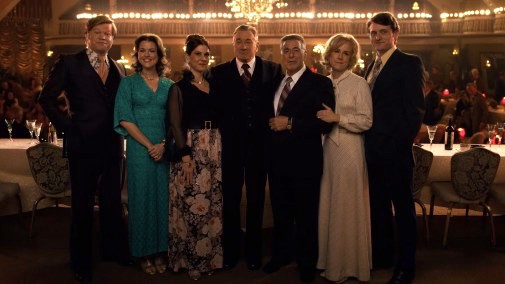
While we may love to criticize the Academy, sometimes we're also a little bit to blame for the perpetuation of their prejudices. For instance, Oscar watchers love to deride the way voters confuse "Best" with "Most". This is especially true in Best Costume Design, where period work rules and contemporary styles are locked out. Still, when a movie is nominated for a wardrobe that's not very glamorous or showy, that prioritizes male attire instead of women's fashion, the grumblings take on another color. Suddenly, it's as if such design work is lesser because it isn't showy.
It's not erroneous to criticize the costume branch for being so myopic this year, having only singled out Best Picture nominees. However, to look at the costumes of The Irishman and say they're unworthy of praise is utter nonsense…

Pardon the harsh language, but The Irishman is a design achievement of the uttermost excellence and it's been frustrating for this costume enthusiast to see it so lambasted.
For starters, costume designers Sandy Powell and Christopher Peterson had to contend with the dramatization of nearly 60 years of history, not to mention hundreds upon hundreds of costume changes for the main cast. The sheer magnitude of that challenge is fearsome and it would be easy to condone some stylistic shortcuts in the face of it. And yet The Irishman's costumes show no shortcuts. They are attuned to history and character, but they're also part of a singular cinematic aesthetic.

Starting with simple, but noticeable things, let's talk about patterns and textiles. Sandy Powell's a good person to challenge the notion that only directors can be auteurs for it's almost impossible to confuse her work with any other designer's. Her films are always dressed in explosions of well-coordinated patterns and contrasting textiles with even the simplest of garments made visually interesting with a pop of unexpected texture. In Carol, she made some dreary Santa hats look luxurious in deep red velvet and in The Irishman she uses hundreds of different prints to add a punch of variation to the picture's images. Look through this movie's footage and you'll seldom find a tie in a solid color, for instance. They're always vibrant with geometric motifs or other patterns, both period-appropriate and aesthetically fun.

It's not only the ties. There's also the suits with interesting textures, a little girl's attire mixing up to five different striped textiles and other such weird quirks of style. The key to the success of such bold choices is how they don't call attention to themselves, fitting into the overall construction of the film, adding flavor but not distracting from the main ingredients. Color also plays a big part, working in unison with the sets and cinematography to create the illusion of a biography gradually drained of liveliness. In other words, in the 50s we have warm bright tones and they start to fade into shades of gray as the titular character gets closer to his last day on Earth.

For fashion history buffs The Irishman is also a delight because of its gradual evolution of styles across 20th century America. While it's true most of the epic's characters are men who spend their lives in sharp suits, Powell and Peterson found canny ways to characterize them through evolution or the lack thereof. Russell, for instance, is always elegant but his fashion sense tends to be two steps behind everyone else. Jimmy Hoffa's sense of conventional suiting never changes, putting him in sharp contrast with the snazzy stylings of someone like Tony Pro and his disrespectful shorts. The mob wives may look up to date, but they're démodé in comparison with their daughters, clinging to the beauty standards of their heyday rather than going with the flow of the times.

And then there's Frank and his attachment to the watch Jimmy gave him and the ring presented to him by Russell. He always wears them on the same hand, forever bound to those two men. Such details of costuming elevate The Irishman, helping build up its complicated central characters and the times they lived through.
That said, the most amazing instances of costuming in the movie are its crowd scenes, always full of supporting actors dressed with the care that's usually only afforded to stars. The extras look like period photographs come to life. Think of those smoky restaurants full of sharp-dressed men in capo collars, a Miami rally that negotiates formality with the Florida heat, a pastel wedding in all the horror of the 1970s craze for colorful polyester.

Do you agree that The Irishman deserved its Costume Design Oscar nomination?